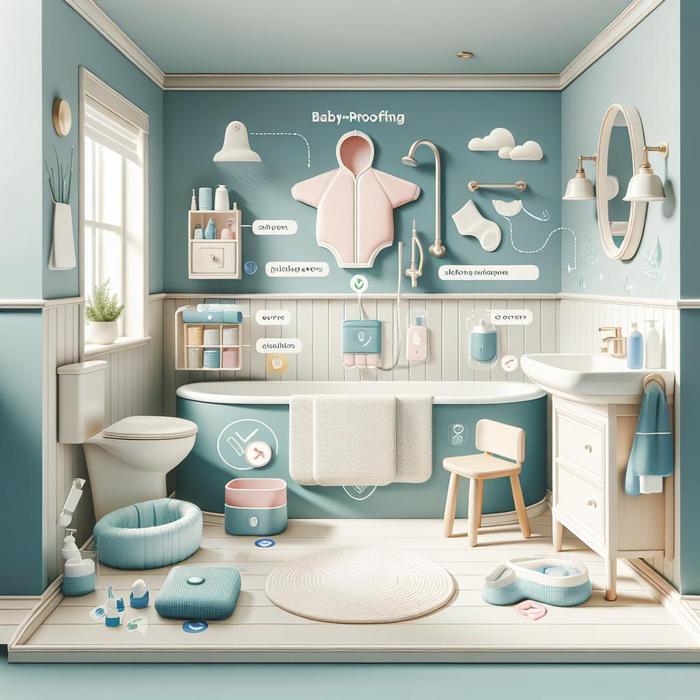Getting Started with Bathroom Baby-Proofing
Childproofing our homes is an essential task that we as parents can’t afford to overlook. It’s all about preventing accidents and ensuring the safety of our little ones as they explore their surroundings. When we embarked on childproofing our home, the bathroom was one of our top priorities. In this blog, we’ll share with you why we decided to childproof our bathroom, and the steps we took to do it safely and effectively.
Why the Bathroom is a Danger Zone
A bathroom can be a potential danger zone for small children. It’s filled with hard surfaces, sharp corners, and potentially toxic substances. As parents, we found it critical to take measures to mitigate these risks. The following are some of the elements that compelled us to prioritize bathroom baby-proofing:
- Water can pose a significant risk of accidental drowning. According to the childproofing experts, even an inch of water can be dangerous for a small child.
- The access to various small objects that a child can swallow, like razors, bottle caps, and even toilet paper, can be dangerous.
- There’s also the risk of little fingers getting caught in doors, drawers, or toilet lids.
- Cleaning supplies and medicines, if not stored properly, can pose serious risks if ingested by a curious toddler.
Essential Safety Checks
After recognizing the potential dangers, we conducted comprehensive safety checks. This involved evaluating all possible hazards and figuring out how to best counter them. Here’s what we did:
- We assessed all reachable objects, removing potential choking hazards or items that could cause harm if ingested or mishandled.
- We tested all locks and latches, ensuring they were high enough to be out of reach for our little one as he grows.
- We paid special attention to evaluate the safety of the bathtub area, which is notorious for slips and falls.
- We scrutinized storage areas, ensuring that cleaning products, medications, and other harmful substances were safely out of reach.
Bathroom Baby-Proofing Tips
After carrying out the safety checks, we were ready to implement some essential childproofing measures. We found these tips from the New York stylist and Lucie’s List incredibly useful:
- Installing safety latches on drawers and cabinets to prevent access to harmful substances and sharp objects.
- Placing a lock on the toilet to prevent curious little ones from opening it, thus avoiding a potential drowning risk.
- Installing non-slip mats in the bath and on the bathroom floor to prevent slips and falls.
- Implementing soft covers on all hard and sharp corners to prevent injuries.
- Setting up a safety gate to limit access when required.
These measures provided us with a sense of relief, knowing that we’ve done our part in creating a safer environment. As we did with our living room, we made sure that our bathroom was also childproof. However, no childproofing measure can replace adult supervision, so it’s crucial to always keep an eye on your little ones.
Other Parents’ Experiences
Just like us, many other parents have gone through and continue to navigate the childproofing journey. On Reddit’s New Parents section, you’ll find a list of resources and product recommendations for thorough childproofing. It’s valuable to learn from others’ experiences, as it can save you time and offer insightful perspectives.
Potential Hidden Dangers
It may not be obvious, but things we often overlook can pose a threat to our children. Thinking outside the box and anticipating potential dangers was critical for our comprehensive childproofing strategy. We found some potential hidden dangers:
- Contact with bathroom appliances such as hair dryers, straighteners, or curlers could lead to burns.
- Exposure to dangerous mold can be harmful.
- Toddlers can ingest harmful toiletries.
- Scaffolding materials like towels or toilet paper can lead to falls.
- Excessive heat from the water can cause burns.
Bathroom Childproofing: A Practical Approach
Drawing on the knowledge and advice of experts, as well as considering the risks mentioned above, we have developed a practical approach to baby proofing our bathroom. Following are some of the steps we took:
- Investing in cabinet and drawer locks. This is essential, especially for those that store medicine and toiletries. The cabinet and drawer locks recommended by Mom Loves Best were highly reliable.
- Installing anti-scald devices on faucets and showerheads. These help control the water temperature and reduce the chances of burns.
- Installing spout covers on tub faucets to safeguard against bumps and potential serious injuries.
- Using toilet locks to prevent accidental falls into the toilet.
- Installing a sturdy and non-climbable safety gate to control access to the bathroom when it’s not being used.
Learning from Others
Throughout this process, it was hugely beneficial to learn from others’ experiences. We understood that baby proofing isn’t a one-time process, but a continuous one with the child’s growth. Drawing insights from guides like Pampers’ Baby Proofing Your Home and wikiHow’s How to Childproof a Bathroom were instrumental in our journey.
Resources such as Childproofing Your Home by the U.S. Consumer Product Safety Commission offered valuable tips. Additionally, engaging in discussions over various parenting platforms helped us understand common issues and innovative solutions.
Keeping Safety Top of Mind
Remember, childproofing a bathroom is just one part of creating a safe environment for your child. Keep safety top of mind no matter where in your home your child is exploring. We hope our experiences and strategies might be helpful, but be sure to always evaluate your home’s safety from your child’s perspective and make changes as necessary.
Our baby-proofing journey doesn’t end here, and we invite you to continue to follow it. Who knows, your insights might even help other parents!
